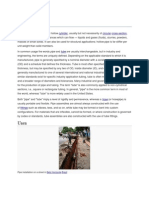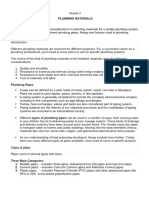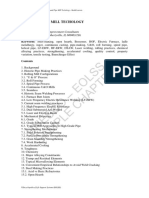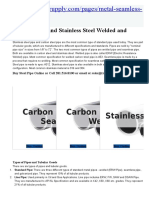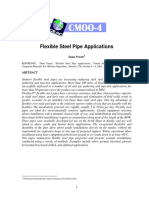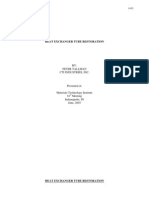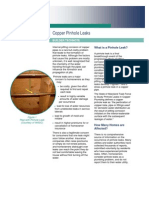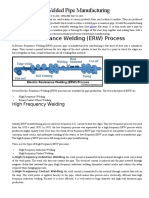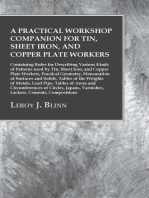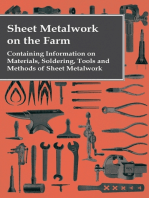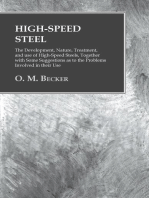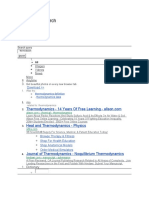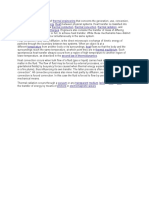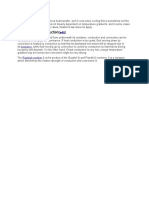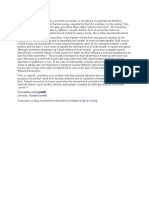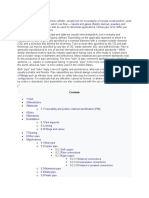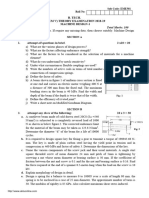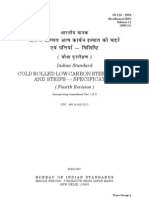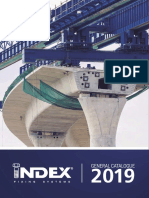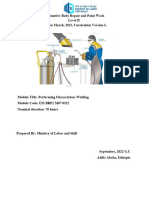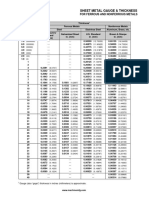0 ratings0% found this document useful (0 votes)
29 viewsMaterials: Submerged Arc Welded
Materials: Submerged Arc Welded
Uploaded by
Mat ComiaERW pipes are manufactured through an electric resistance welding process using steel coil. The HFI welding process uses induction coils to weld ERW pipes. Larger diameter pipes over 25 cm can be manufactured through longitudinal or spiral submerged arc welding processes using steel plates or coils.
Copyright:
© All Rights Reserved
Available Formats
Download as DOCX, PDF, TXT or read online from Scribd
Materials: Submerged Arc Welded
Materials: Submerged Arc Welded
Uploaded by
Mat Comia0 ratings0% found this document useful (0 votes)
29 views2 pagesERW pipes are manufactured through an electric resistance welding process using steel coil. The HFI welding process uses induction coils to weld ERW pipes. Larger diameter pipes over 25 cm can be manufactured through longitudinal or spiral submerged arc welding processes using steel plates or coils.
Original Title
Pipe Engineering
Copyright
© © All Rights Reserved
Available Formats
DOCX, PDF, TXT or read online from Scribd
Share this document
Did you find this document useful?
Is this content inappropriate?
ERW pipes are manufactured through an electric resistance welding process using steel coil. The HFI welding process uses induction coils to weld ERW pipes. Larger diameter pipes over 25 cm can be manufactured through longitudinal or spiral submerged arc welding processes using steel plates or coils.
Copyright:
© All Rights Reserved
Available Formats
Download as DOCX, PDF, TXT or read online from Scribd
Download as docx, pdf, or txt
0 ratings0% found this document useful (0 votes)
29 views2 pagesMaterials: Submerged Arc Welded
Materials: Submerged Arc Welded
Uploaded by
Mat ComiaERW pipes are manufactured through an electric resistance welding process using steel coil. The HFI welding process uses induction coils to weld ERW pipes. Larger diameter pipes over 25 cm can be manufactured through longitudinal or spiral submerged arc welding processes using steel plates or coils.
Copyright:
© All Rights Reserved
Available Formats
Download as DOCX, PDF, TXT or read online from Scribd
Download as docx, pdf, or txt
You are on page 1of 2
be removed from both inner and outer surfaces using a scarfing blade.
The weld zone can also be
heat-treated to make the seam less visible. Welded pipe often have tighter dimensional tolerances
than the seamless type, and can be cheaper to manufacture.
There are a number of processes that may be used to produce ERW pipes. Each of these processes
leads to coalescence or merging of steel components into pipes. Electric current is passed through
the surfaces that have to be welded together; as the components being welded together resist the
electric current, heat is generated which forms the weld. Pools of molten metal are formed where the
two surfaces are connected as a strong electric current is passed through the metal; these pools of
molten metal form the weld that binds the two abutted components.
ERW pipes are manufactured from the longitudinal welding of steel. The welding process for ERW
pipes is continuous, as opposed to welding of distinct sections at intervals. ERW process uses steel
coil as feedstock.
The High Frequency Induction Technology (HFI) welding process is used for manufacturing ERW
pipes. In this process, the current to weld the pipe is applied by means of an induction coil around
the tube. HFI is generally considered to be technically superior to “ordinary” ERW when
manufacturing pipes for critical applications, such as for usage in the energy sector, in addition to
other uses in line pipe applications, as well as for casing and tubing.
Large-diameter pipe (25 centimetres (10 in) or greater) may be ERW, EFW or Submerged Arc
Welded ("SAW") pipe. There are two technologies that can be used to manufacture steel pipes of
sizes larger than the steel pipes that can be produced by seamless and ERW processes. The two
types of pipes produced through these technologies are longitudinal-submerged arc-welded (LSAW)
and spiral-submerged arc-welded (SSAW) pipes. LSAW are made by bending and welding wide
steel plates and most commonly used in oil and gas industry applications. Due to their high cost,
LSAW pipes are seldom used in lower value non-energy applications such as water pipelines.
SSAW pipes are produced by spiral (helicoidal) welding of steel coil and have a cost advantage over
LSAW pipes, as the process uses coils rather than steel plates. As such, in applications where
spiral-weld is acceptable, SSAW pipes may be preferred over LSAW pipes. Both LSAW pipes and
SSAW pipes compete against ERW pipes and seamless pipes in the diameter ranges of 16”-24”.
Tubing for flow, either metal or plastic, is generally extruded.
Materials[edit]
Historic water mains from Philadelphia included wooden pipes
Pipe is made out of many types of material including ceramic, glass, fiberglass,
many metals, concrete and plastic. In the past, wood and lead (Latin plumbum, from which comes
the word 'plumbing') were commonly used.
Typically metallic piping is made of steel or iron, such as unfinished, black (lacquer) steel, carbon
steel, stainless steel, galvanized steel, brass, and ductile iron. Iron based piping is subject to
corrosion if used within a highly oxygenated water stream. [2] Aluminum pipe or tubing may be utilized
where iron is incompatible with the service fluid or where weight is a concern; aluminum is also used
for heat transfer tubing such as in refrigerant systems. Copper tubing is popular for domestic water
(potable) plumbing systems; copper may be used where heat transfer is desirable (i.e. radiators or
heat exchangers). Inconel, chrome moly, and titanium steel alloys are used in high temperature and
pressure piping in process and power facilities. When specifying alloys for new processes, the
known issues of creep and sensitization effect must be taken into account.
Lead piping is still found in old domestic and other water distribution systems, but is no longer
permitted for new potable water piping installations due to its toxicity. Many building codes now
require that lead piping in residential or institutional installations be replaced with non-toxic piping or
that the tubes' interiors be treated with phosphoric acid. According to a senior researcher and lead
expert with the Canadian Environmental Law Association, "...there is no safe level of lead [for human
exposure]".[3] In 1991 the US EPA issued the Lead and Copper Rule, it is a federal regulation which
limits the concentration of lead and copper allowed in public drinking water, as well as the
permissible amount of pipe corrosion occurring due to the water itself. In the US it's estimated that
6.5 million lead service lines (pipes that connect water mains to home plumbing) installed before the
1930s are still in use.[4]
Plastic tubing is widely used for its light weight, chemical resistance, non-corrosive properties, and
ease of making connections. Plastic materials include polyvinyl chloride (PVC),[5] chlorinated
polyvinyl chloride (CPVC), fibre reinforced plastic (FRP),[6] reinforced polymer mortar (RPMP),
[6]
polypropylene (PP), polyethylene (PE), cross-linked high-density
polyethylene (PEX), polybutylene (PB), and acrylonitrile butadiene styrene (ABS), for example. In
many countries, PVC pipes account for most pipe materials used in buried municipal applications for
drinking water distribution and wastewater mains.[5] Market researchers are forecasting total global
revenues of more than US$80 billion in 2019.[7] In Europe, market value will amount to approx. €12.7
billion in 2020 [8]
Pipe may be made from concrete or ceramic, usually for low-pressure applications such as gravity
flow or drainage. Pipes for sewage are still predominantly made from concrete or vitrified
clay. Reinforced concrete can be used for large-diameter concrete pipes. This pipe material can be
used in many types of construction, and is often used in the gravity-flow transport of storm water.
Usually such pipe will have a receiving bell or a stepped fitting, with various sealing methods applied
at installation.
Traceability and positive material identification (PMI)[edit]
When the alloys for piping are forged, metallurgical tests are performed to determine material
composition by % of each chemical element in the piping, and the results are recorded in a Material
Test Report (MTR). These tests can be used to prove that the alloy conforms to various
specifications (e.g. 316 SS). The tests are stamped by the mill's QA/QC department and can be
used to trace the material back to the mill by future users, such as piping and fitting manufacturers.
Maintaining the traceability between the alloy material and associated MTR is an important quality
assurance issue. QA often requires the heat number to be written on the pipe. Precautions must also
be taken to prevent the introduction of counterfeit materials. As a backup to etching/labeling of the
material identification on the pipe, positive material identification (PMI) is performed using a
handheld device; the device scans the pipe material using an e
You might also like
- Welded Steel Pipe Design ManualDocument93 pagesWelded Steel Pipe Design ManualfileseekerNo ratings yet
- Cylinder Circular Cross-Section: Pipe Installation On A Street inDocument8 pagesCylinder Circular Cross-Section: Pipe Installation On A Street inMohit BauskarNo ratings yet
- Cylinder Circular Cross-Section: Pipe Installation On A Street inDocument4 pagesCylinder Circular Cross-Section: Pipe Installation On A Street inMohit BauskarNo ratings yet
- Manufacture: Centrifugal Casting BilletDocument7 pagesManufacture: Centrifugal Casting BilletJordan MosesNo ratings yet
- PipeDocument14 pagesPipefawxesNo ratings yet
- CH 1: Materials Used in Pipework & Plumbing FittingsDocument10 pagesCH 1: Materials Used in Pipework & Plumbing FittingsEmad BassemNo ratings yet
- Science behind PipesDocument26 pagesScience behind Pipeskirkb597No ratings yet
- Pipe Fitting - InfosDocument2 pagesPipe Fitting - InfosAnonymous bHuVkYPc4No ratings yet
- Study of Carbon Steel Pipes 2013Document26 pagesStudy of Carbon Steel Pipes 2013Deepak Ramchandani100% (1)
- Piping and Plumbing FittingDocument25 pagesPiping and Plumbing Fittingignatus lupapuloNo ratings yet
- Tube (Fluid Conveyance) - WikipediaDocument3 pagesTube (Fluid Conveyance) - Wikipediaramthecharm_46098467No ratings yet
- SteelPipe Versus DIPDocument10 pagesSteelPipe Versus DIPHichem BenniaNo ratings yet
- Piping 2Document7 pagesPiping 2Jeffrey SsalonNo ratings yet
- All Document Reader 1720419937639Document7 pagesAll Document Reader 1720419937639Vhinna HabbilingNo ratings yet
- Analysis and Optimization of Parameters For Casting Ductile Iron PipesDocument27 pagesAnalysis and Optimization of Parameters For Casting Ductile Iron PipesSurajit SahaNo ratings yet
- PipingDocument4 pagesPipingzidaaanNo ratings yet
- Unesco - Eolss Sample Chapters: Steel and Pipe Mill TechologyDocument11 pagesUnesco - Eolss Sample Chapters: Steel and Pipe Mill TechologymiladrahimianNo ratings yet
- The Difference Between Spiral Submerged Arc Welded Steel Pipe and Straight Seam Steel PipeDocument14 pagesThe Difference Between Spiral Submerged Arc Welded Steel Pipe and Straight Seam Steel Pipemusacihan100% (1)
- Piping DesignDocument65 pagesPiping DesignShrey PatelNo ratings yet
- Piping: For Other Uses, See,, Bagpiping, Or, orDocument4 pagesPiping: For Other Uses, See,, Bagpiping, Or, orHarlon BartolomeNo ratings yet
- Piping Stress 123Document8 pagesPiping Stress 123Arun NambiarNo ratings yet
- Piping: Kevin D. Rafferty, P.E. Geo-Heat CenterDocument6 pagesPiping: Kevin D. Rafferty, P.E. Geo-Heat CenterMahmoud Magdy RizkNo ratings yet
- Pipe SpecificationDocument11 pagesPipe SpecificationSajib Chandra RoyNo ratings yet
- Types of Pipeline SytemsDocument4 pagesTypes of Pipeline SytemsCK CastilloNo ratings yet
- Piping - WikipediaDocument6 pagesPiping - Wikipediaramthecharm_46098467No ratings yet
- Piping: Piping Sometimes Refers To Piping Design, The Detailed Specification of TheDocument5 pagesPiping: Piping Sometimes Refers To Piping Design, The Detailed Specification of Thesiswout100% (1)
- Flexible Steel Pipe Applications: Dana FraserDocument15 pagesFlexible Steel Pipe Applications: Dana FraseraishahNo ratings yet
- Water SupplyDocument9 pagesWater SupplyUzair mukhtarNo ratings yet
- Pipes. Strength of Pipe Water Carrying Capacity Life and Durability of Pipe Expenditure On Transportation Jointing Process, Maintenance and RepairsDocument23 pagesPipes. Strength of Pipe Water Carrying Capacity Life and Durability of Pipe Expenditure On Transportation Jointing Process, Maintenance and Repairssoft4youNo ratings yet
- Pipe Is A Long Hollow Cylinder Used Chiefly To Convey FluidDocument1 pagePipe Is A Long Hollow Cylinder Used Chiefly To Convey FluidG-one PaisonesNo ratings yet
- Material Components Learner HandoutDocument86 pagesMaterial Components Learner HandoutankushNo ratings yet
- To Understand The Production of Steel PipeDocument8 pagesTo Understand The Production of Steel PiperameshNo ratings yet
- Selection of Pipe For A Drinking Water Project A Case StudyDocument8 pagesSelection of Pipe For A Drinking Water Project A Case StudymNo ratings yet
- Piping: Kevin D. Rafferty, P.E. Geo-Heat Center Klamath Falls, Oregon 97601Document19 pagesPiping: Kevin D. Rafferty, P.E. Geo-Heat Center Klamath Falls, Oregon 97601danianpdNo ratings yet
- Pipe (Material) : Pipe Is A Hollow Cylinder of Material. It Differs FromDocument5 pagesPipe (Material) : Pipe Is A Hollow Cylinder of Material. It Differs FromSyed Aftab AhmedNo ratings yet
- Plumbing Materials of Fitting 3Document44 pagesPlumbing Materials of Fitting 3Jenneth Cabinto DalisanNo ratings yet
- 555 MMN332Document16 pages555 MMN332khaireddinNo ratings yet
- Heat Exchanger Tube Restoration: BY: Peter Tallman Cti Industries, IncDocument9 pagesHeat Exchanger Tube Restoration: BY: Peter Tallman Cti Industries, IncTerrence EbinumNo ratings yet
- Unit 4Document28 pagesUnit 4ZahidNo ratings yet
- Problems With GI Piping in Water SupplyDocument4 pagesProblems With GI Piping in Water SupplyPravin GoelNo ratings yet
- Module 3 Lesson 1 Plumbing MaterialssDocument13 pagesModule 3 Lesson 1 Plumbing MaterialssCherry MuycoNo ratings yet
- Copper Pinhole LeaksDocument5 pagesCopper Pinhole Leakshspringer1No ratings yet
- The First L555 (X80) Pipeline in JapanDocument11 pagesThe First L555 (X80) Pipeline in JapanMarcelo Varejão CasarinNo ratings yet
- Black Steel PipesDocument14 pagesBlack Steel Pipes25616313No ratings yet
- Introduction To Welded Pipe ManufacturingDocument6 pagesIntroduction To Welded Pipe Manufacturingana danNo ratings yet
- FRP PipingDocument19 pagesFRP PipingprocesspipingdesignNo ratings yet
- A Fracture Mechanics Approach For Analyzing Spiral Weld Pipes Containing CracksDocument9 pagesA Fracture Mechanics Approach For Analyzing Spiral Weld Pipes Containing CracksaladinsaneNo ratings yet
- 1 PipelineDocument69 pages1 PipelineEhab MohammedNo ratings yet
- Ductile Iron Pipes and Fittings DN 80-1000 MMDocument24 pagesDuctile Iron Pipes and Fittings DN 80-1000 MMMahtheerNo ratings yet
- Piping and Plumbing Fittings PDFDocument5 pagesPiping and Plumbing Fittings PDFmichol201450% (4)
- Sexton's Pocket-Book for Boiler-Makers and Steam Users: Comprising a Variety of Useful Information for Employer and Workmen, Government Inspectors, Board of Trade Surveyors, Engineers in Charge of Works and Ships, Foreman of Manufactories, and the General Steam-Using PublicFrom EverandSexton's Pocket-Book for Boiler-Makers and Steam Users: Comprising a Variety of Useful Information for Employer and Workmen, Government Inspectors, Board of Trade Surveyors, Engineers in Charge of Works and Ships, Foreman of Manufactories, and the General Steam-Using PublicNo ratings yet
- A Practical Workshop Companion for Tin, Sheet Iron, and Copper Plate Workers: Containing Rules for Describing Various Kinds of Patterns used by Tin, Sheet Iron, and Copper Plate Workers, Practical Geometry, Mensuration of Surfaces and Solids, Tables of the Weights of Metals, Lead Pipe, Tables of Areas and CircumferencesFrom EverandA Practical Workshop Companion for Tin, Sheet Iron, and Copper Plate Workers: Containing Rules for Describing Various Kinds of Patterns used by Tin, Sheet Iron, and Copper Plate Workers, Practical Geometry, Mensuration of Surfaces and Solids, Tables of the Weights of Metals, Lead Pipe, Tables of Areas and CircumferencesNo ratings yet
- Heat-Treatment of Steel: A Comprehensive Treatise on the Hardening, Tempering, Annealing and Casehardening of Various Kinds of Steel: Including High-speed, High-Carbon, Alloy and Low Carbon Steels, Together with Chapters on Heat-Treating Furnaces and on Hardness TestingFrom EverandHeat-Treatment of Steel: A Comprehensive Treatise on the Hardening, Tempering, Annealing and Casehardening of Various Kinds of Steel: Including High-speed, High-Carbon, Alloy and Low Carbon Steels, Together with Chapters on Heat-Treating Furnaces and on Hardness TestingRating: 1 out of 5 stars1/5 (1)
- Sheet Metalwork on the Farm - Containing Information on Materials, Soldering, Tools and Methods of Sheet MetalworkFrom EverandSheet Metalwork on the Farm - Containing Information on Materials, Soldering, Tools and Methods of Sheet MetalworkNo ratings yet
- Tool-Steel - A Concise Handbook on Tool-Steel in General - Its Treatment in the Operations of Forging, Annealing, Hardening, Tempering and the Appliances ThereforFrom EverandTool-Steel - A Concise Handbook on Tool-Steel in General - Its Treatment in the Operations of Forging, Annealing, Hardening, Tempering and the Appliances ThereforNo ratings yet
- Forging - Manual of Practical Instruction in Hand Forging of Wrought Iron, Machine Steel and Tool Steel; Drop Forging; and Heat Treatment of Steel, Including Annealing, Hardening and TemperingFrom EverandForging - Manual of Practical Instruction in Hand Forging of Wrought Iron, Machine Steel and Tool Steel; Drop Forging; and Heat Treatment of Steel, Including Annealing, Hardening and TemperingRating: 5 out of 5 stars5/5 (1)
- Triangulation - Applied to Sheet Metal Pattern Cutting - A Comprehensive Treatise for Cutters, Draftsmen, Foremen and Students: Progressing from the Simplest Phases of the Subject to the Most Complex Problems Employed in the Development of Sheet Metal Patterns with Practical Solutions of Numerous Problems of Frequent Occurrence in Sheet Metal ShopsFrom EverandTriangulation - Applied to Sheet Metal Pattern Cutting - A Comprehensive Treatise for Cutters, Draftsmen, Foremen and Students: Progressing from the Simplest Phases of the Subject to the Most Complex Problems Employed in the Development of Sheet Metal Patterns with Practical Solutions of Numerous Problems of Frequent Occurrence in Sheet Metal ShopsRating: 5 out of 5 stars5/5 (1)
- Wrought Ironwork - A Manual of Instruction for Rural CraftsmenFrom EverandWrought Ironwork - A Manual of Instruction for Rural CraftsmenRating: 5 out of 5 stars5/5 (1)
- High-Speed Steel - The Development, Nature, Treatment, and use of High-Speed Steels, Together with Some Suggestions as to the Problems Involved in their UseFrom EverandHigh-Speed Steel - The Development, Nature, Treatment, and use of High-Speed Steels, Together with Some Suggestions as to the Problems Involved in their UseNo ratings yet
- Sample ThesisDocument5 pagesSample ThesisMat ComiaNo ratings yet
- Web Results: Mechanical Shafts - Gear - Stress (Mechanics) - ScribdDocument4 pagesWeb Results: Mechanical Shafts - Gear - Stress (Mechanics) - ScribdMat ComiaNo ratings yet
- Yahoo Web Search: SettingsDocument6 pagesYahoo Web Search: SettingsMat ComiaNo ratings yet
- Research Paper SampleDocument7 pagesResearch Paper SampleMat ComiaNo ratings yet
- Accessibility Help3Document3 pagesAccessibility Help3Mat ComiaNo ratings yet
- Web Results: Solved: How Much Torque Can A Cone Clutch Transmit If The ..Document4 pagesWeb Results: Solved: How Much Torque Can A Cone Clutch Transmit If The ..Mat ComiaNo ratings yet
- Skip To Main Contentaccessibility HelpDocument3 pagesSkip To Main Contentaccessibility HelpMat ComiaNo ratings yet
- Thermal Engineering Thermal Energy Heat Thermal Conduction Thermal Convection Thermal Radiation Phase ChangesDocument1 pageThermal Engineering Thermal Energy Heat Thermal Conduction Thermal Convection Thermal Radiation Phase ChangesMat ComiaNo ratings yet
- Convection vs. Conduction: BuoyancyDocument1 pageConvection vs. Conduction: BuoyancyMat ComiaNo ratings yet
- Sizes: Nominal Pipe SizeDocument2 pagesSizes: Nominal Pipe SizeMat ComiaNo ratings yet
- Convective Heat Transfer Fluids Mass Transfer: Convection-CoolingDocument1 pageConvective Heat Transfer Fluids Mass Transfer: Convection-CoolingMat ComiaNo ratings yet
- Pipe Is A Tubular Section or Hollow: o o o o o o o o oDocument3 pagesPipe Is A Tubular Section or Hollow: o o o o o o o o oMat ComiaNo ratings yet
- Carbon Steel Tubes Buy Stainless Steel Coil Ferrite Meter MF300F+Document8 pagesCarbon Steel Tubes Buy Stainless Steel Coil Ferrite Meter MF300F+Stoyan PetkovNo ratings yet
- Miginox 309L / Tiginox 309L: Aws A/Sfa 5.9 EN ISO 14343-ADocument1 pageMiginox 309L / Tiginox 309L: Aws A/Sfa 5.9 EN ISO 14343-AJagannath SahuNo ratings yet
- C-02 Model 7707 Heavy Duty Flexible Coupling - Rev-UDocument3 pagesC-02 Model 7707 Heavy Duty Flexible Coupling - Rev-UDaniel SanNo ratings yet
- Carbon Structural Steels: National Standard of The People'S Republic of ChinaDocument8 pagesCarbon Structural Steels: National Standard of The People'S Republic of ChinaNicolás GuerreroNo ratings yet
- 303 Stainless Steel Material Data SheetDocument3 pages303 Stainless Steel Material Data SheetBlack LotusNo ratings yet
- 1614326892027-Objective Questions On Material Science MET-09Document20 pages1614326892027-Objective Questions On Material Science MET-09मधु हांसदाNo ratings yet
- Industrial Training Report Cargo TankDocument9 pagesIndustrial Training Report Cargo TankMuhammad FirdawsNo ratings yet
- Astm A463 - A463 M - 09 - Especificação para Chapas de Aço Revestidas de AlumínioDocument7 pagesAstm A463 - A463 M - 09 - Especificação para Chapas de Aço Revestidas de AlumínioAnderson TeixeiraNo ratings yet
- Jwell Bathroom Accessories CatalogueDocument40 pagesJwell Bathroom Accessories CatalogueAnubhav VermaNo ratings yet
- UTP Tool Welding BrochureDocument12 pagesUTP Tool Welding Brochurekamals55No ratings yet
- EG-C-403E Anchor Bolts Rev 5Document10 pagesEG-C-403E Anchor Bolts Rev 5Vicente Aparecido Pineda Ferrari Jr.No ratings yet
- Machine Design PyqDocument66 pagesMachine Design PyqUTKARSH MISHRANo ratings yet
- 8-Thermit WeldingDocument21 pages8-Thermit WeldingRamu AmaraNo ratings yet
- UNIT 4 - Phase Rule and AlloysDocument30 pagesUNIT 4 - Phase Rule and AlloysgsuryasanjaiNo ratings yet
- Navtec TurnbucklesDocument7 pagesNavtec TurnbucklesNed VasicNo ratings yet
- Is 513 - 1994 - r2003 - Cold Rolled Low Carbon Steel SheetsDocument11 pagesIs 513 - 1994 - r2003 - Cold Rolled Low Carbon Steel SheetsRam Niwas100% (3)
- Index Catalogue English 2019Document18 pagesIndex Catalogue English 2019api-513440808No ratings yet
- Samson 3271 ActuatorDocument6 pagesSamson 3271 ActuatorGiri BabuNo ratings yet
- Acerinox Stainless Steel GradesDocument1 pageAcerinox Stainless Steel GradesLLNo ratings yet
- Innershield NR - 203 Nickel (1%) : Conformances Key FeaturesDocument1 pageInnershield NR - 203 Nickel (1%) : Conformances Key FeaturesH_DEBIANENo ratings yet
- C042011020 With Cover Page v2Document11 pagesC042011020 With Cover Page v2Weses narniaNo ratings yet
- M07 Perform Oxyacetylene WeldingDocument93 pagesM07 Perform Oxyacetylene WeldingGizaw TadesseNo ratings yet
- Sheet Metal Gauge ChartDocument1 pageSheet Metal Gauge Chart1k-of-1kNo ratings yet
- Art 28 Anode Inspection and Defect Definition Rev00Document3 pagesArt 28 Anode Inspection and Defect Definition Rev00soltani aliNo ratings yet
- Iso 1459 1973Document4 pagesIso 1459 1973Didi Sulaiman AbduhNo ratings yet
- GENERAL4 Answer-1Document4 pagesGENERAL4 Answer-1ابومحمد الكنانيNo ratings yet
- DownloadDocument162 pagesDownloadJawad HanifNo ratings yet
- G+1 Residential Building Bill of Quantity YITAYALDocument31 pagesG+1 Residential Building Bill of Quantity YITAYALYemane TsadikNo ratings yet
- DHV - Swing Check ValvesDocument5 pagesDHV - Swing Check ValvesAndry HermawanNo ratings yet
- Astm A447Document4 pagesAstm A447Đoàn Thoại Đông TriềuNo ratings yet

